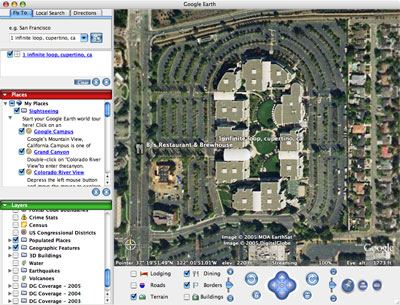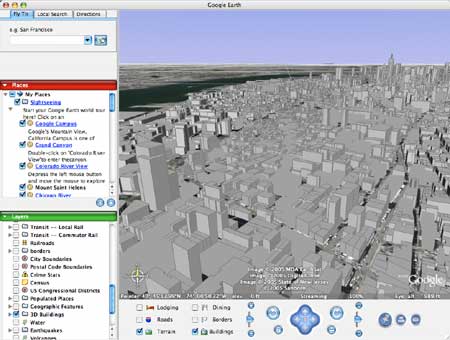Via Divester comes another example of how geographic content can be made to come alive by integrating it with Google Earth. Dive-spots.com lists dive spots in the Florida Keys area; when you drill down to an individual dive spot, you get the option to save the location in your favourites, download the GPX file for your GPS device, see a map or download the KML and open it in Google Earth. (You may have to register.) The locations are usually in shallow water, so in some cases you actually get to see [KML] the artifacts in Google Earth below the water’s surface. Very nice.
Category Archives: Content
Migration and Google Earth
Here is a new (to me) use of Google Earth: Gary Hodges has made a network link that maps the migration patterns of early Pennsylvanian settlers as they head westwards from the port circa 1750-1850. He locates Indian villages and forts as well. More info on his blog.
Which reminds me of an early item on the wishlist for a future feature in Google Earth: The ability to play a KML file as a series of timed events, so that, for example, we can see historical battles played out, see the spread of the avian flu virus over time, or even just watch a hurricane as a series of time-lapse images. KML files certainly already have the ability to time-encode individual objects (though the feature is undocumented), so they could be shown only at specified time intervals if there were a play button to be pressed. Historical geographic information already encoded in KML files, such as many of the WWII overlays uploaded to Google Earth Hacks, would certainly benefit from the added metadata.
And, thinking a bit out of the box, imagine Wikipedia linking from its articles on historic battles to network links of those battles, accurately positioned in both space and time. If there were sufficient amounts of such historical KML files, properly time-coded, we’d be able to engage in grand tours of history, incorporating antique map overlays, battle sequences, migration routes and national borders, all of them changing dynamically as we watch the years tick by. Basically, we’d be smearing out all Google Earth has to offer into the fourth dimension. Not an entirely new thought, perhaps, but worth savouring every so often:-)
Google Earth for Mac OS X beta (pre-release): Usage notes
I got myself a copy of the Google Earth for Mac OS X beta application, a prerelease that was let loose on the web this morning, and have now played with it for a while. Here are my usage notes, including news of a special feature in the Mac version that is not in the PC version (near the end of the post, alas).
Test machines were an Apple PowerMac G5 Quad with an NVIDIA 6600, crippled by just 512 MB of RAM, and a PowerBook G4 Titantium 867MHz with an ATI Mobility Radeon 9000 and 1GB of RAM. Both run OS X 10.4.3. The internet connection is 100 Mbps downstream (bless Sweden).
First impression: It works very well for a prerelease and it’s as impressive as when I saw Google Earth on the PC for the first time..
Second impression. 512 MB is not enough to run this. The Quad experiences hiccups amid the scrolling, no doubt because the limited memory needs to engage in gymnastics as the application sucks in new data. So plan to get at least 1GB of RAM to play with Google Earth for Mac.
The PowerBook performed well, as long as you don’t go and hover over New York and turn on 3D buildings. Given sufficient RAM, it certainly looks likely that anything equivalent to a late model Titanium will be able to make good use of this application.
Click to enlarge.
3D buildings are still a bit iffy in the Mac prerelease beta. In New York, certain buildings along a N/S E/W grid lacked shading and borders. That’s the case on both Macs, so its unlikely to be a graphics card artifact. However, the transparency slider for overlays works fine, as do all the network links I’ve tested, save for rendering images inside info boxes (such as the National Geographic content).
All the items in the Layers and Places panels are identical, including the icons, but that’s because they are fed by a server, not hard-coded in the application.
Feature-wise, Menu items are identical, right down to the icons. The Measure tool works, Image Overlay works, adding placemarks works, the Overview map works, Snapshot View works… pretty much everything works, except for Web, which currently leads to a white space where on the PC we get a web browser. The Email function isn’t implemented yet. (“Sorry about this” says the pop-up window. Don’t be!) Other functions require Google Earth Plus, as on the PC.
In my preferences folder there is now a “com.Google.GoogleEarthPlus.plist”. My grabby hand/cursor went transparent once, so I trashed this file and the hand was back upon a relaunch.
The only showstopper I found is choosing Full Screen. That presents you with a full screen of white that you need to quit out of. I never got this application to crash properly, though.
Options are called Preferences in Google Earth for Mac, and these are nearly exactly indentical to the PC counterpart, pane by pane, down to the choice between Open GL and Direct X as the Graphics Mode (Choosing Direct X seems to have no effect on the Mac, even though in the About box it will then say that the renderer is DirectX 8. Weird.).
There is one feature in the Mac version that doesn’t exist on the PC version. The Mac version has an additional viewing mode: There’s Trackball, G-Force, and Click-and-Zoom, just like in the PC version, but also Camera, which turns the controls into something akin to the yoke of a small plane (I imagine). Takes a bit of getting used to, but it can be handy for making fine adjustments to snapshots. Or pretending to be an out-of-control astronaut.
In sum, if you’re a Mac enthusiast who’s been pining after this application, this prerelease version already lets you be far more productive than running it in Virtual PC. In fact, as long as you remember that this is not a public release, and that some features are not ready yet, this version is perfectly usable.
PS Currently there is no AppleScript support (not that I was expecting any:-), but there is this: in the application’s info.plist (look inside the application’s package contents):
<key>NSAppleScriptEnabled</key>
<string>YES</string>
Which means that Google Earth gets listed as scriptable. And that’s indeed the case. When you try to open the Dictionary via Script Editor, however, nothing happens.
PPS When downloading a KML or KMZ file in Firefox for the first time, it will ask you if you want to open it automatically in a certain application. This way, future clicks on KML or KMZ files on the web will open them directly in Google Earth.
If you are downloading KML or KMZ files from Safari and want them to open automatically in Google Earth, you are apparently out of luck.
PPPS For reference’s sake, this version of Google Earth for Mac is 3.1.0371.0 (beta), built on December 1, 2005.
Google Earth for OS X, III
Florida’s Jaron Brass actually reviews a Beta of Google Earth for Mac. A few bugs remain, he says, but it otherwise coasts along nicely. (It might help that he has a tricked-out G5 Quad PowerMac.)
[Update 10:18 UTC: Here’s another, briefer review, which notes that performance on the PowerBook is apparently fine as well.]
Google Earth for OS X, II
Browsing through AppleInsider’s image gallery of Google Earth for OSX screenshots, I came across the About box. Note the line “Operating System: Mac OS X”, which to me suggests that the application is the product of a multi-platform development effort. This would gel with the look and feel of the buttons in the other screenshots, which some commenters on the AppleInsider article have said looks like earlier versions of the OS, circa 10.1 and 10.2. To me, however, it looks more like an X11- or Java-based application (just like WW2D, in fact). I could be wrong, though:-)
Google Earth for Mac OS X almost here, with screenshots!
Earlier this month, a pre-release version of Google Earth for Mac OS X that uses OpenGL rendering reportedly began making the rounds overseas. The 40MB application packs a hefty set of preferences, allowing users to tweak detail and color, and control the speed of their “flights.”
Reportedly? It’s the first I’ve heard of it. The article mentions “sources” who confirm what Google has already publicly promised — that a Mac OS X version is underway. But the proof would appear to be in the screenshot (large), helpfully centered on the Cupertino campus.

You’ll notice the layout is practically identical to the PC version, but with Mac-like control buttons. At 40MB, the application would also be significantly larger than the 13MB PC version. There’s an outside chance this is a hoax, of course. But an avid Mac user myself, I’m certainly hoping this gets onto my Mac by Xmas.
Considering that Microsoft Live Local doesn’t even work on Safari, Google can expect an enthusiastic adoption of GEOSX by Mac users. (Content-wise, Live Local’s maps of Europe now easily beat Google Maps, though.)
I’m quite glad Google’s business model is advertising-driven, in the main, because this kind of model has to be platform neutral to be effective. It’s why there won’t be an ESRI ArcGis Explorer for Mac. Microsoft, on the other hand, is about making its operating system as attractive as possible to potential customers, and finding synergies among its products. Platform agnosticism in their customers is what they’d rather not have.
Google Earth data update, with massive improvements for the UK
A post on the official Google Earth Community has the details: A large chunk of the UK is now in 6-inch resolution, there are further updated or improved images for Sydney, Cairo, Mexico City, Quito and Bangalore, among others, at 0.7m resolution, and much more. You need to restart Google Earth to benefit.
